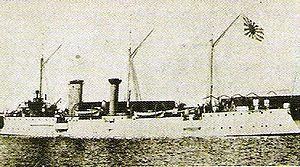Name Chishima Laid down 29 January 1890 Commissioned 24 November 1892 Launched 26 November 1890 Draft 2.97 m | Ordered 1887 Fiscal Year Completed 1 April 1892 Construction started 29 January 1890 Length 71 m | |
 | ||
Fate Lost in collision, 30 November 1892 | ||
Chishima (千島, Chishima) was an unprotected cruiser of the Imperial Japanese Navy. The name Chishima (lit. "Thousand Islands") is the Japanese name for the Kurile Islands. Chishima was used by the Imperial Japanese Navy as an aviso (dispatch boat) for scouting, reconnaissance and delivery of high priority messages.
Contents
Background
Chishima was designed by French military advisor Émile Bertin, and built in the Ateliers et Chantiers de la Loire shipyards in Saint-Nazaire, France. It was part of the 1882 pre-First Sino-Japanese War expansion program of the Imperial Japanese Navy. In keeping with the Jeune Ecole philosophy of naval warfare advocated by Bertin, Chishima was small and lightly armed, so much so that sometimes Chishima has been confused with a torpedo gunboat or destroyer.
Design
Chishima was a slightly older design, which included a full barque rigging with three masts for auxiliary sail propulsion in addition to her steam engine. Chishima was armed with two 76 mm (3 in) guns in sponsons on each side, with a fifth gun mounted in the bows. Secondary armament consisted of six 37 mm (1.5 in) 1-pounder guns mounted in pairs on the bridge, poop deck and one on each side. In addition, she carried five torpedoes, mounted on the deck.
Service record
The commissioning of Chishima was delayed by over a year, as the ship could achieve only 19 knots (35 km/h), instead of the promised 22 knots (41 km/h); the French government agreed to pay the Japanese government some financial compensation for the issue. The shakedown cruise of Chishima was made on its voyage to Japan, with a crew of 80 Japanese and eleven French technicians, via Alexandria, the Suez Canal and Singapore. The ship suffered from numerous problems on this voyage, including boiler failure, leaks, and ruptured steam lines, before finally arriving at Nagasaki.
However, Chishima was lost only one week after its formal commissioning into the Japanese navy, in a night collision on 30 November 1892 with the British P&O merchant vessel Ravenna (3257 tons), off Matsuyama, Ehime prefecture, at 33°55′N 132°39′E in poor weather. The larger merchant ship struck Chishima amidships, cutting her into two. Her captain and 74 sailors on board drowned, but Ravenna suffered only minor damage. This incident led to the establishment of the Japanese "Maritime Anti-Collision Regulations".
One of the cannons of Chishima is preserved in a memorial at Aoyama Cemetery in Tokyo, and a memorial to the Chishima disaster with calligraphy by Tōgō Heihachirō is at the Buddhist temple of Jofuku-ji in Matsuyama.
Litigation following sinking
Afterwards, in a maritime tribunal held by the British consular court in Kobe, P&O was cleared. The Japanese Government then brought action against P&O in the British Court for Japan. P&O sought to file a counterclaim which the judge in the Court for Japan, Robert Mowat, rejected as not being within the jurisdiction of the court. P&O appealed to the British Supreme Court for China and Japan in Shanghai (Hannen CJ and Jamieson J) which allowed the counterclaim. The Japanese Government then appealed to the Judicial Committee of the Privy Council who allowed the appeal and held P&O was not allowed to counterclaim.
The case was remitted to the British Court for Japan for trial. P&O then settled the case by paying the Japanese government 10,000 pounds sterling in compensation, which corresponded roughly to the purchase cost of the ship, but provided for no compensation to the families of the lost officers and crew. The Japanese government had to bear its own legal costs. The British captain was not fined nor imprisoned for his responsibility in the incident. The settlement was regarded as highly unfair by the Japanese public, and was one issue cited in the drive for revision of the unequal treaties between Japan and the western nations to bring an end to extraterritoriality.
